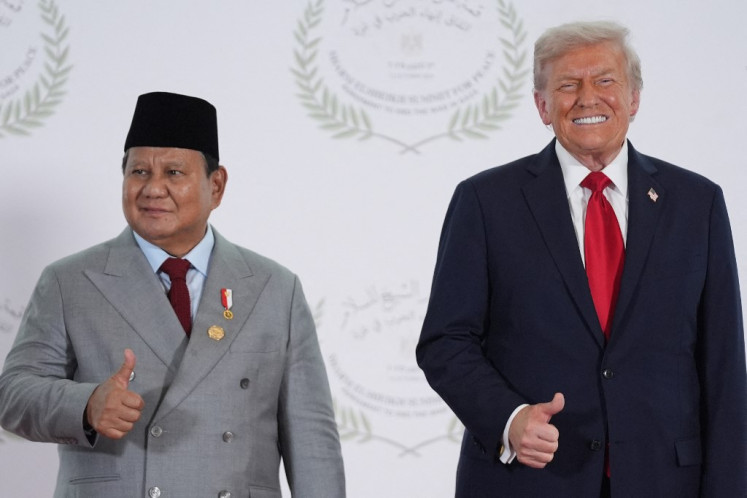Popular Reads
Top Results
Can't find what you're looking for?
View all search resultsPopular Reads
Top Results
Can't find what you're looking for?
View all search resultsFood policy and the environmental credit crunch
Human civilization has advanced considerably over the course of the last two decades
Change text size
Gift Premium Articles
to Anyone
H
uman civilization has advanced considerably over the course of the last two decades. This is not the result of the Internet, smartphones or even the spread of democracy, but instead something far more fundamental.
The current generation is the first ever to know a world where famine can be defeated by modern economics. Globalization of transportation networks, agricultural productivity and medical knowledge have combined to make famine an accident of human policy (wars etc), but not an accident of nature.
At the same time that humanity can celebrate this achievement ' for achievement it certainly is ' there is a threat lurking. The (relative) cornucopia of plenty has bred a sense of complacency about food that is certain to be challenged by the economic and environmental circumstances of the next generation.
The way we eat now is financed by a considerable borrowing of environmental credit. Humanity is consuming tomorrow's finite resources to provide low cost food in an environmentally unsustainable manner at the point when the numbers of humans on the planet are about to swell still further.
The challenge is the interaction of politics and economics that conspires against an environmentally desirable outcome.
Food occupies a peculiar place in the mind of the average consumer. As a high frequency purchase, food is something the consumer is acutely price sensitive about. Politicians know this, and so the price of food is something that is important to policy makers.
This is a major issue in Asia. Since 2007, food price inflation has exceeded total inflation at least two thirds of the time in every key economy in the region bar Singapore, and in several economies (including China, Indonesia, Thailand and Malaysia) food inflation has almost always been higher than total inflation.
Politicians and markets have an incentive to provide as much food as possible, as cheaply as possible, today. Not much has changed from the demand for 'bread and circuses' in ancient Rome.
Today it may be 'pizza and reality TV', but the importance of food as a source of popular well-being, and thus political stability, is as relevant today as it was two millennia ago. The fact that food is produced at the cost of finite resources (the energy required to produce fertilizer, for instance) or at the cost of environmental degradation (soil erosion) is overlooked .
The political imperative of providing cheap food today overwhelms the politically abstract but environmentally certain cost of more expensive food in the future.
So how can economics and environment be reconciled, at a time of rising population and finite resources? There is, in fact, a solution that is at once both simple and complex, which my colleague Julie Hudson and I have written about in our recent book Food Policy and the Environmental Credit Crunch: From Soup to Nuts.
The global food crunch can be solved by controlling food waste.
In a developed economy like the United States, around 50 percent of food is wasted.
What is often overlooked in the moral outrage at such statistics is that in an emerging market like India around 50 percent of food is never consumed either.
The difference between the two societies is where the food waste takes place. In a developed economy waste is primarily at the end of the food 'food-chain', with the consumer throwing away uneaten food.
In an emerging market waste occurs far earlier in the food chain, generally in the distribution network that lies between farmer and market. Reducing that food waste, even moderately, would easily provide the calories that a growing global population requires.
'Cutting waste' is the simple part of the policy prescription. The difficulty is the complexity of the way in which our food reaches us today.
Well-meaning attempts to control waste at a personal level can end up as some environmental game
of 'whack a mole'; waste is controlled in one area only to pop up defiantly elsewhere in the distribution process in response to changing behaviour.
What is needed is to invest in waste control in an intelligent manner; seeking to control waste across the entire food food-chain (accepting that such a strategy may increase waste in one area, but generate greater efficiency overall).
This is where private investment should focus. Food is an increasingly politically contentious area. Investing in agricultural land or food retail may lead to higher returns, but as an investment it could just as equally be subject to price controls, export bans, or constraints on foreign ownership.
Investing in technologies or business practices that promote efficient food consumption and minimise waste across the entire food food-chain are less susceptible to nationalistic political pressure.
Moreover, such investments can produce an outcome that is optimal both in an environmental and an economic sense.
_____________
The writer is deputy head of Global Economics, UBS. Food Policy and the Environmental Credit Crunch: From Soup to Nuts by Julie Hudson and Paul Donovan was published by Routledge in October.










